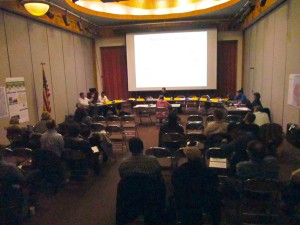Bethel’s rural status is not immediately at risk. But once the population hits 7,000, it will be presumed to be non-rural unless it proves to have rural characteristics.
The federal subsistence board is in a multi-year process of reviewing how it decides which communities have the critical rural priority for accessing resources on federal lands as described under ANILCA.
That process was the subject of a meeting in Bethel Wednesday, but most people gave their thoughts on Bethel.

Alan Joseph said that the population thresholds are somewhat arbitrary.
“Say if the community became non-rural at 7,000 it would be like telling Yup’iks in Bethel that at 12 o’clock that that stop being Yup’iks,” Joseph said. “You have to look at the way the people live and decide to keep it that way.”
There are communities above 7,000 people still considered rural, like Sitka and Kodiak. To remain rural, they have to show rural characteristics. Mary Gregory made the case that subsistence is at the core of many people’s lives.
“If you come to my house right now you will find 10 pikes hanging in my kitchen trying to dry out and a string of tomcods that are also hanging and my house smells like fish because I’m a 99.9 percent subsistence food user,” Gregory said. “A lot of people are like that, especially the elderly people who live here.”
Ignacious Louie Andrew recognized that change has accelerated in recent years, but the basic native values are still strong:
“We have gone through a tremendous changes, but as we continue to change, subsistence traditional native practices and values will provide a continuity to the past,” Andrew said..
Bethel specifically sees a lot of turnover, according to Roberta Chavez.
“People come and go to bethel all the time you see them moving here, leaving here,” Chavez said. “The people that remain have been here since time immemorial and they have the right to continue to live that way.”
There are a total of 10 meetings happening all around the state. Comments will be analyzed and brought to the Federal Subsistence Board. Steve Kessler works as the Forest Service’s subsistence program leader and says the comments are important to the process.
“Are these thresholds guidelines the correct ones to use, or should we be using something else,” Kessler said. “Should we be aggregating communities in some other way?”
“What does the public think the federal subsistence board and the secretaries of interior and agriculture ought to be using to determine which communities are rural?”
The board will meet in April and could propose changes to pass up to the Secretaries of Interior and Agriculture, who ultimately make the call. You can give comments by emailing subsistence@fws.gov. The deadline for comments is Dec. 2.
Ben Matheson is a contributor with the Alaska Public Radio Network.




